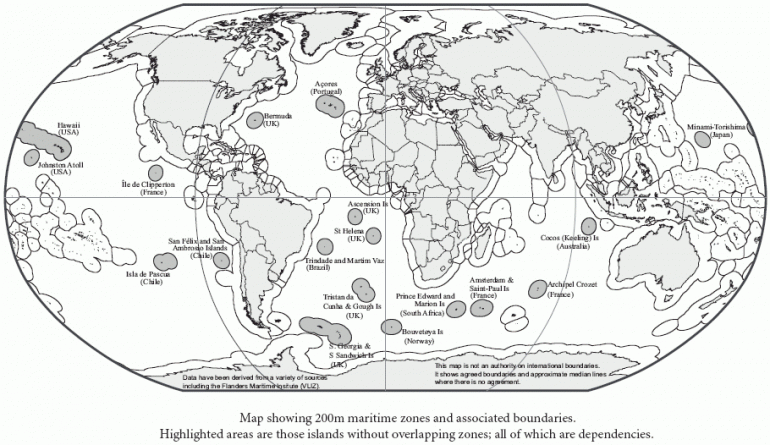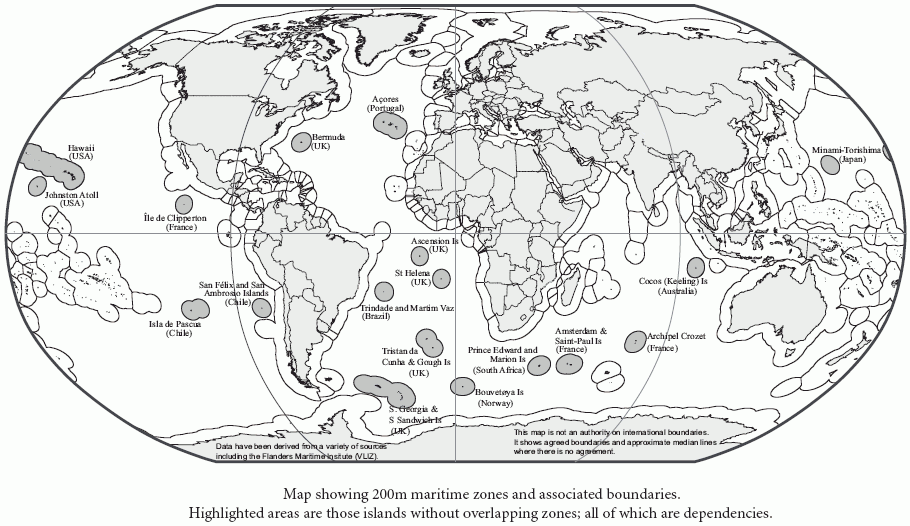Maritime Delimitation and Associated Questions


Source: Dr Robin Cleverly, Head, Law of the Sea, UK Hydrographic Office, Taunton
2. Territorial Sea Delimitation Between Opposite or Adjacent States7
Where the coasts of two States are opposite or adjacent to each other, neither of the two States is entitled, failing agreement between them to the contrary, to extend its territorial sea beyond the median line every point of which is equidistant from the nearest points on the baselines from which the breadth of the territorial seas of each of the two States is measured. The above provision does not apply, however, where it is necessary by reason of historic title or other special circumstances to delimit the territorial seas of the two States in a way which is at variance therewith.
Article 15 stipulates primacy of agreement, and failing that, application of the principle of equidistance. Departure from the equidistance principle is possible only where necessary by reason of historic title or other ‘special circumstances’.11 Thus a presumption of equidistance exists in the case of the territorial sea, justified by the comparatively small distances involved.
References(p. 284) Given the institutional age of the territorial sea, many of the disputes surrounding its application have been resolved. Major cases have included Qatar v Bahrain,12 Caribbean Sea,13 Guyana v Suriname,14 Eritrea v Yemen,15 and Bangladesh/Myanmar16 but several decisions were handed down pre-UNCLOS, notably the Banks of Grisbadarna between Norway and Sweden17 and the St Pierre and Miquelon arbitration between France and Canada.18 Following the Qatar v Bahrain and Caribbean Sea maritime delimitations, a methodology19 has developed; in Caribbean Sea the Court considered the application of the following process in the context of an UNCLOS Article 15 territorial sea boundary delimitation:
(1) Consideration should first be given to the drawing of a provisional line of equidistance.20
(2) But the provisional equidistance line may be abandoned due to special circumstances.21
(3) The tribunal in question may then consider its own means of delimitation, or adopt those proposed by the parties.22
(4) At all stages, the tribunal will need to take into account relevant coasts, including the geography of the immediate coastline, the delimitation of the territorial sea of adjacent states and geomorphological features of the area adjacent to the endpoint of a land boundary.23
References(p. 285) Whether or not there is a formal presumption of equidistance in territorial sea delimitation may be debated, but it is certainly the norm.
3. Continental Shelf Delimitation Between Opposite or Adjacent States24
(A) Sources
In cases where the continental shelf extends to the shores of another State, or is shared with an adjacent State, the boundary shall be determined by the United States and the State concerned in accordance with equitable principles.25
At this time there was almost no delimitation practice: the 1942 Gulf of Paria Treaty, the first seabed delimitation treaty, represented an attempt by Venezuela and the UK to delimit the Gulf, a shallow inland sea between the British colony of Trinidad and the Venezuelan coast.26 At its core, the treaty simply described three lines according to longitude and latitude, allocating to the UK those areas east and north of these lines.27
Practice was not much further advanced upon consideration by the ILC beginning in 1953.28 On cartographical advice, the ILC proposed and the Geneva Conference adopted GCCS Article 6.29 Article 6 applies to those cases where the ‘same continental shelf ’ extends between opposite or adjacent states. In separate provisions, it stipulates that the boundary is determined by agreement but ‘in the absence of agreement, and unless another boundary line is justified by special circumstances’, the boundary shall be determined by a median line, that is, a line equidistant from the nearest points of the baselines from which the breadth of the territorial sea of each state is measured.
Article 83(1) appears as an elaborated version of the Truman Proclamation provision concerned with delimitation. To that extent UNCLOS Part VI had returned to its customary law origins.32
(B) The Established Approach
The Convention sets a goal to be achieved, but is silent as to the method to be followed to achieve it. It restricts itself to setting a standard, and it is left to the States themselves, or the courts, to endow this standard with specific content.35
Thus the justice of which equity is an emanation, is not abstract justice but justice according to the rule of law; which is to say that its application should display consistency and a degree of predictability; even though it looks with particularity to the peculiar circumstances of an instant case, it also looks beyond it to principles of more general application.36
Taking account of the differences in coastal length, the Court adopted a proportionality test to justify deviation from the median line,37 while stressing that it was not required to achieve a predetermined ratio between the relevant coasts and the respective continental shelf areas.38
References(p. 287) As a result of this and subsequent decisions, a ‘received approach’ has emerged, though it is not invariable.39 This is first to draw provisionally an equidistance line.40 If this proves inappropriate, the court or tribunal may use a different method of delimitation, such as the bisector method, according to which the line is formed by bisecting the angle created by a linear approximation of coastlines.41 The court may then move to consider whether the line so created must be adjusted in the light of ‘relevant circumstances’, such as small islands, maritime features or coastal geography. An equidistance line is usually seen as the most equitable starting point for any delimitation. The ‘relevant circumstances’ that have been produced by custom are similar to the ‘special circumstances’ seen in GCCS Article 6.42
Accordingly, delimitation of the continental shelf is usually done in three stages. First, the relevant tribunal establishes a provisional delimitation line based on ‘methods that are geometrically objective and also appropriate for the geography of the area in which the delimitation is to take place’.43 This provisional delimitation line is an equidistance line in case of two adjacent coasts, and a median line when two opposite coasts are concerned.44 Secondly, the tribunal considers whether there are ‘relevant circumstances’ calling for the adjustment or shifting of the provisional equidistance line in order to achieve an equitable result.45 Thirdly, the tribunal verifies that the delimitation line as it stands does not lead to an inequitable result by reason of any marked disproportion between the ratio of the respective coastal lengths and the ratio between the relevant maritime area of each state.46
(C) The Equitable Principles
The notion that an equidistance line is the ordinary starting point for continental shelf delimitation is only one of the equitable principles governing the solution under UNCLOS Article 83(1) and customary international law. The ‘equitable principles’, as defined judicially since North Sea Continental Shelf, have a normative character as a part of general international law, and their application is to be distinguishedReferences(p. 288) from decision-making ex aequo et bono.47 Nonetheless the ‘principles’ are general in character. As was noted in Libya/Malta, the term ‘equitable’ in Article 83(1) sets an amorphous standard.48 Nonetheless, specific criteria or indicia have emerged. These may be formulated as follows:
(1) Delimitation is to be effected by agreement on the basis of international law.49
(2) As far as possible neither party should encroach on the natural prolongation of the other (the principle of non-encroachment).50
(3) As far as possible, there should be no undue cut-off of the seaward projection of the coast of either of the states concerned.51
(4) Delimitation is to be effected by the application of equitable criteria and by the use of practical methods capable of ensuring, with regard to the geographical configuration of the area and other relevant circumstances, an equitable result.52
(5) There is a mild presumption that the equitable solution is an equal division of the areas of overlap of the continental shelves of the states in dispute.53
(D) Relevant Circumstances
The application of equitable principles involves (variously) reference to the ‘relevant circumstances’, or ‘factors to be taken into account’, or ‘auxiliary criteria’.54 Relevant circumstances recognized by international tribunals include the following:
(1) the general configuration of the coasts of the parties;55
(2) disregarding or giving less than full effect to incidental features (e.g. minor offshore islands) which would otherwise have a disproportionate effect on the delimitation;
References(p. 289) (3) disparity of coastal lengths in the relevant area;56
(4) the general geographical framework or context;57
(5) the principle of equitable access to the natural resources of the disputed area.58
Factors sometimes referred to, but not as well accepted, include:
(6) the geological structure of the sea-bed and its geomorphology (or surface features);59
(7) the conduct of the parties, such as the de factoline produced by the pattern of grants of petroleum concessions in the disputed area;60such concessions need to be, however, premised on express or tacit agreement between the parties;61
(8) the incidence of natural resources in the disputed area;62
(9) defence and security interests of the states in dispute;63
(10) navigational interests of the states in dispute;64
(11) consistency with the general direction of the land boundary;65
(12) maritime delimitations already effected in the region.66
Some comment is called for on several of these.
As to the second factor, given a geographical situation of quasi-equality as between coastal states, it is often necessary to abate the effects of an incidental special feature from which an unjustifiable difference of treatment would result. This principle has been employed to avoid, or at least to diminish, the effects of a concave coast,67 the location of islands of state A near the coast of state B68 and the eccentric alignment ofReferences(p. 290) small islands lying off a peninsula.69 On occasion, the effect of a group of islands has been reduced by half when the geography was not markedly eccentric.70
As to existing or reasonably-suspected incidence of resources, resource-related criteria have been treated much more cautiously by international courts and tribunals, which have not generally applied this factor as a relevant circumstance—at least explicitly.71 An exception—concerning delimitation within 200nm—was Jan Mayen,, where a portion of the line was adjusted to a take account of Danish access to an established capelin fishery.72 Thus in the context of a single maritime boundary, considerations relating to the EEZ determined the location of a shelf boundary.
[A]lthough there may be no legal limit to the considerations which States may take account of, this can hardly be true for a court applying equitable procedures. For a court, although there is assuredly no closed list of considerations, it is evident that only those that are pertinent to the institution of the continental shelf as it has developed within the law, and to the application of equitable principles to its delimitation, will qualify for inclusion. Otherwise, the legal concept of continental shelf could itself be fundamentally changed by the introduction of considerations strange to its nature.73